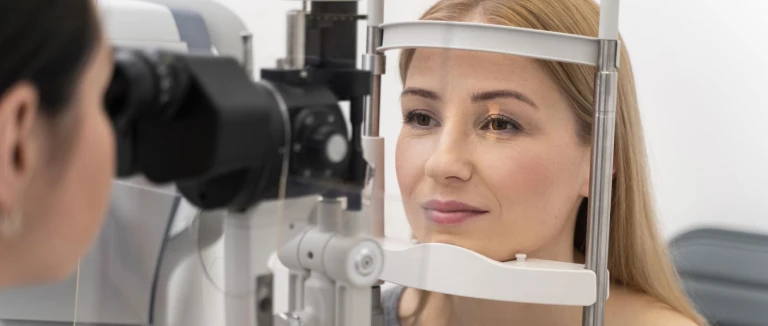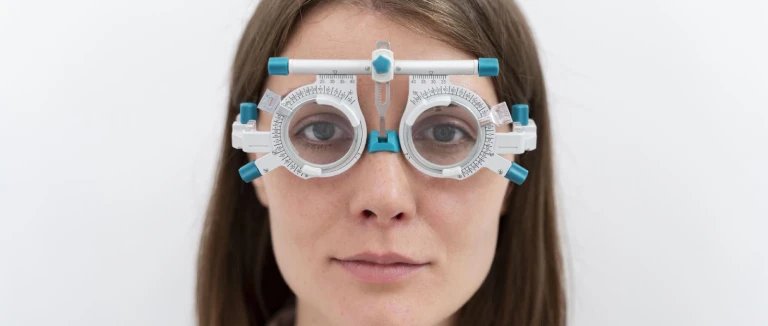i-LASIK in Turkey: Advanced Laser Eye Surgery for Clear Vision
I-Lasik is a form of laser vision correction surgery designed to address refractive errors. With this approach, the cornea is reshaped using a femtosecond laser, which operates in ultrafast pulses rather than a microkeratome blade. This technology leads to fewer complications and delivers more consistent outcomes. For those seeking freedom from corrective eyewear, i-Lasik in Türkiye presents a compelling solution.

What is i-Lasik Laser?
iLASIK is a reliable bladeless procedure that effectively corrects common refractive errors like myopia, hyperopia, and astigmatism. This treatment is notable for its low complication rates and rapid recovery period. Throughout the surgery, a femtosecond laser creates a corneal flap, followed by vision improvement through precise corneal reshaping using a laser.
How is i-Lasik Surgery Performed?
Assessment of a patient's prescription is required prior to iLASIK surgery. This evaluation enables the surgeon to understand eye shape and corneal thickness. The process starts with the administration of local anesthetic eye drops. Afterward, a femtosecond laser is used to fashion a flap on the cornea. The laser then takes about 10 minutes to reshape the cornea and correct vision. Once finished, the corneal flap is set back into place. Postoperative drops help lower the risk of infection.
Who is Eligible For i-Lasik Laser?
iLASIK eye treatment may not be suitable for everyone, the necessary eligibility criteria can be listed as follows:
- Being over the age of 18.
- The eye number not changing in the last 12 months.
- Not being pregnant or breastfeeding.
- Appropriate cornea thickness.
- Appropriate eye defect type.
- Having a healthy eye structure.

What are the i-Lasik Treatment Methods?
iLASIK utilizes cutting-edge laser technology to accurately address eye imperfections. The following are some of the sophisticated approaches featured in i-Lasik laser procedures in Türkiye:
- Femtosecond laser technology
- Wavefront technology
- Special design laser
- Iris tracking
Wavefront
Wavefront technology constructs a 3D image of the eye's optical layer, enabling light refraction measurements at every single point. Special software then evaluates these data points, designing a customized treatment strategy to pinpoint and resolve vision issues. This method is a top choice for i-Lasik in Türkiye because of its individualized approach and strong record of positive results.
How Long Does the i-Lasik Surgery Take?
iLASIK is a brief laser-based surgery, typically completed in 15-20 minutes for both eyes. If performed on just one eye, the operation takes a shorter time. However, the duration can differ based on the individual's eye anatomy and the intricacy of the procedure.
Is i-Lasik Surgery Safe?
The safety of i-Lasik stems from exact computer programming that guides the laser throughout the operation. An advanced fixation tool holds the eye steady and tracks movement, ensuring the laser remains perfectly targeted. This equipment maintains ideal eye alignment to prevent misdirected laser application. Adhering to post-surgery instructions is essential, as following medical advice helps limit complications and further enhances the security of recovery.
Is i-Lasik Treatment Permanent?
For most individuals, iLASIK delivers lasting vision correction when performed successfully. Nonetheless, factors like aging or new eye conditions may affect this permanence over time. Additionally, if post-treatment care is neglected or complications emerge, recovery could be slower and the durability of the results might diminish.

What are the Advantages of i-Lasik Eye Laser?
iLASIK stands out for several reasons when compared to other LASIK laser procedures. The main strengths of the i-Lasik eye laser are as follows:
- Personalized solution: iLASIK is tailored to match each patient's unique eye anatomy. As a result, every phase of treatment is specifically planned, enhancing overall effectiveness.
- Minimally invasive approach: Compared to standard LASIK techniques, iLASIK causes less disruption to tissue due to its minimally invasive nature.
- Quicker recovery period: Reduced tissue impact enables a swifter healing process after iLASIK, letting patients resume their routines soon after surgery.
- Reduced side effects: Temporary symptoms like dry eyes, light sensitivity, or blurred vision may occur, but they are generally milder than those seen with other LASIK techniques.
- Greater success rate: The individualized nature and careful application of iLASIK promote high satisfaction and excellent treatment outcomes.
- Lower risk of complications: The combination of a gentle technique and brief procedure time means complications are uncommon with iLASIK.
- Rapid, reliable care: With an average procedure lasting just 15“20 minutes, iLASIK delivers prompt and dependable vision correction.
What are the Disadvantages of i-Lasik Eye Laser?
While iLASIK provides effective vision improvement and has many benefits, it's not without drawbacks. Below are some potential disadvantages associated with i-Lasik treatment:
- Complications: Although it is rare after i-Lasik treatment, complications such as infection, corneal injury, light line or night vision problems, dry eye, flashes or tremors in vision may occur.
- Dry Eyes: After treatment, the feeling of dryness in the eyes is a common side effect. This dryness feeling may persist for a long time in some patients and may be uncomfortable.
- Price: iLASIK treatment may be more expensive than other glasses or contact lens options, or compared to other treatment methods.
- Ineligible candidates: One of the important disadvantages of i-Lasik treatment is that it is not a suitable treatment for everyone. For example, people with insufficient corneal tissue, unstable eye numbers, or eye infections cannot benefit from iLASIK treatment.
How Long is the i-Lasik Laser Healing Process?
While the healing journey following iLASIK laser therapy varies slightly for each patient, it is generally swift. Provided there are no setbacks, the majority of people can resume their usual activities within a matter of days. Temporary effects such as blurred or double vision and a mild sensitivity to light are expected for several days after the procedure. Typically, these symptoms resolve naturally and may be eased by medication. It is common for patients to notice slight redness or swelling in their eyes during the first week. Consistently using eye drops as directed by your physician and shielding your eyes from any harm can help ensure a faster recovery.
What are the Differences Between i-Lasik and LASIK?
In contrast to conventional Lasik, i-Lasik utilizes an advanced mapping process to create a more customized solution. By generating a three-dimensional digital imprint of the patient's eye surface with specialized optical devices, this technique helps the laser adapt precisely to each individual's unique eye shape, making the reshaping of the cornea highly specific and accurate.
How Should Eye Care Be After i-Lasik Treatment?
Once i-Lasik treatment is complete, proper eye care is crucial and avoiding situations that might harm your vision is essential. Attention to aftercare following i-Lasik helps promote healing and safeguard the eyes from any potential irritants or injuries:
- The eyes should not be rubbed
- The eyes should be moisturized regularly
- Eye makeup should not be applied
- Sunglasses should be used when going out in the sun
- Heavy exercises should be avoided
- The prescribed medications should be used regularly
- The doctor's recommendations should be followed

The Best i-Lasik Laser Doctors in Türkiye
As a leader in medical innovation, Türkiye stands out as a destination for i-Lasik Laser procedures. The country remains at the forefront of advancing health technologies and benefits from a wealth of experienced professionals. To connect with the top i-Lasik laser specialists in Türkiye, it is advisable to schedule consultations at advanced hospitals equipped with the latest in laser treatment services.
Liv Hospital: See life more beautifully
Liv Hospital distinguishes itself through extensive expertise and outstanding results in i-Lasik Laser treatments. From your first inquiry to the completion of your care, the International Health Services Team at Liv Hospital supports you every step of the way. Welcoming patients from diverse backgrounds, Liv Hospital's skilled staff and expert physicians address a wide range of health concerns. With personalized attention and proven success, Liv Hospital is dedicated to helping you overcome issues like visual disturbances. Contact them for comprehensive information.
* Liv Hospital Editorial Board has contributed to the publication of this content .
* Contents of this page is for informational purposes only. Please consult your doctor for diagnosis and treatment. The content of this page does not include information on medicinal health care at Liv Hospital .
For more information about our academic and training initiatives, visit Liv Hospital Academy
Frequently Asked Questions
What is i-Lasik surgery?
i-Lasik is a bladeless laser eye surgery that reshapes the cornea using femtosecond and excimer lasers to correct myopia, hyperopia, and astigmatism. It offers a precise, safe, and customized solution for vision correction.
How does i-Lasik differ from traditional LASIK?
Unlike traditional LASIK, which uses a mechanical blade, i-Lasik employs laser technology for flap creation. It also includes advanced eye mapping (Wavefront) for highly personalized treatment and improved accuracy.
Is i-Lasik safe?
Yes. i-Lasik is a clinically proven, FDA-approved procedure with minimal risks. The computer-guided laser system ensures precision and safety throughout the operation.
How long does the procedure take?
The i-Lasik surgery typically lasts about 15 to 20 minutes for both eyes. The laser application itself usually takes only a few seconds per eye.
Is the result permanent?
For most patients, the results are long-lasting. However, natural aging or new eye conditions may cause minor vision changes over time.
Who is eligible for i-Lasik?
Ideal candidates are over 18, have stable vision for at least a year, and possess adequate corneal thickness. It’s not suitable for pregnant or breastfeeding women or individuals with certain eye diseases.
How long is the recovery period?
Most patients notice improved vision within 24 hours and can resume daily activities in a few days. Temporary dryness, light sensitivity, or mild blurriness may occur during early recovery.
What precautions should be taken after i-Lasik?
Avoid rubbing your eyes, using makeup, or engaging in heavy exercise for a few days. Wear sunglasses outdoors and use prescribed eye drops as directed by your doctor.
Are there any side effects?
Side effects are rare but may include temporary dry eyes, halos around lights, or mild glare. These usually resolve naturally within a few weeks.
Why choose Liv Hospital for i-Lasik in Türkiye?
Liv Hospital offers advanced technology, experienced eye surgeons, and personalized laser vision correction plans. The hospital ensures safe, precise, and comfortable treatment for patients seeking clear, natural vision.